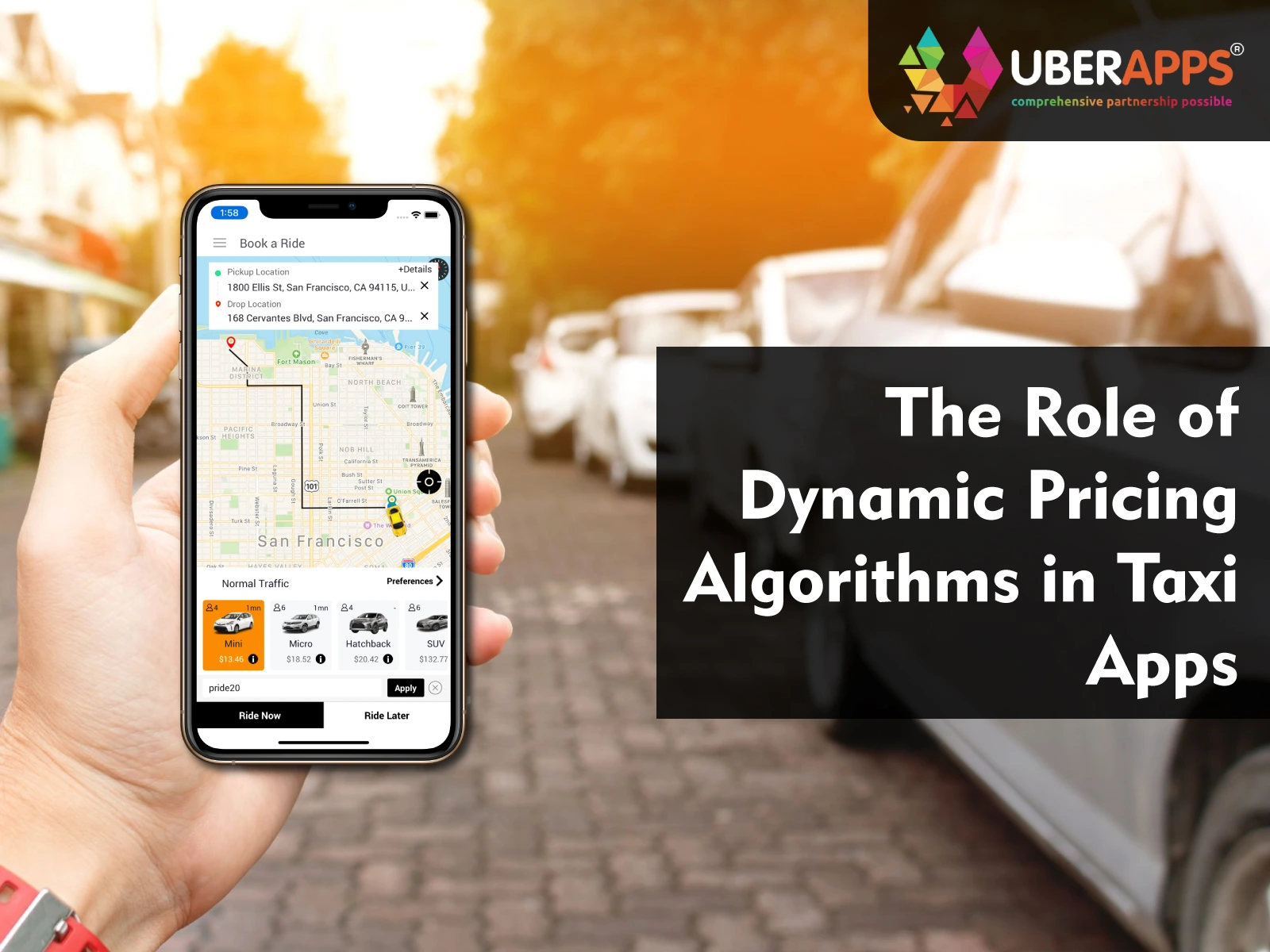
The Role of Dynamic Pricing Algorithms in Taxi Apps
The taxi industry has undergone a massive transformation with the rise of taxi booking apps powered by advanced technology. One of the most significant innovations has been the use of dynamic pricing algorithms. These algorithms allow fares to adjust automatically in real time, based on demand and supply. For operators, this ensures profitability. For drivers, it guarantees fair compensation. For passengers, it improves ride availability even during peak hours.
Dynamic pricing has become a defining feature of ride-hailing app features, influencing how passengers perceive fairness and how drivers respond to demand. Platforms like UberApps, a SaaS-based taxi app solution, help taxi businesses integrate intelligent pricing strategies seamlessly into their operations.
This blog explores how dynamic pricing works, why it matters, its benefits, challenges, and the future of pricing algorithms in the taxi industry.
Data security and privacy are vital in SaaS-based taxi apps as they handle sensitive passenger and driver data daily. With the rise of taxi booking apps like UberApps, operators must ensure strong protection against breaches, fraud, and unauthorized access. Key practices include encrypting sensitive data, securing in-app payments, enforcing strong authentication, and maintaining transparency with users through clear privacy policies. SaaS platforms play a crucial role by embedding compliance, scalable infrastructure, and advanced security tools directly into taxi app development. As threats evolve, innovations like AI threat detection, blockchain payments, and biometric authentication will define the next wave of taxi security. Businesses that prioritize privacy now will gain customer trust and achieve long-term success.
What Is Dynamic Pricing in Taxi Apps?
Dynamic pricing, also known as surge pricing, is the practice of adjusting fares in response to real-time market conditions. Instead of charging passengers a fixed rate, the app uses algorithms to calculate the most appropriate fare at a given time.
Key Factors That Influence Dynamic Pricing
1Passenger Demand
During rush hours, concerts, or holidays, ride requests increase significantly. Algorithms raise fares to balance supply.
2Driver Availability
When fewer drivers are online, prices rise to motivate more drivers to log in.
3Time of Day
Early morning and late-night rides often come with premium pricing due to limited driver availability.
4External Factors
Bad weather, traffic congestion, or local events can trigger surge pricing.
5Example in Action
If it starts raining in a city, ride requests may double while driver availability drops. The app algorithm increases fares by 1.5x or 2x to encourage more drivers to head out and meet demand.
Key takeaway: Dynamic pricing is not about overcharging; it’s about maintaining balance in the ride-hailing ecosystem.
Why Dynamic Pricing Matters in Taxi App Development
1Fair Compensation for Drivers
Drivers often hesitate to work during high-demand times without financial incentives. Dynamic pricing ensures they earn more for working in difficult conditions, such as traffic jams or bad weather.
2Availability of Rides for Passengers
If prices remain fixed during rush hours, drivers may avoid crowded or difficult areas. This leads to longer waiting times and unhappy customers. Dynamic pricing ensures passengers still find rides, even at higher fares.
3Profitability for Operators
Taxi operators benefit from optimized revenue streams. They can reinvest these profits into marketing, technology, and driver incentives, ensuring long-term growth.
Bold takeaway: Without dynamic pricing, taxi businesses risk low driver participation and poor customer satisfaction during peak demand.
The Role of SaaS-Based Taxi Apps in Pricing Algorithms
1Cloud-Powered Pricing Models
SaaS-based taxi apps like UberApps rely on cloud infrastructure to process large volumes of real-time data. These systems continuously monitor market conditions and update fares instantly across multiple cities.
2AI and Machine Learning in Pricing
Advanced algorithms use AI to analyze past ride data, traffic trends, and rider behavior. Over time, machine learning helps refine pricing strategies to optimize profitability while keeping passengers satisfied.
3Multi-City Scalability
For operators expanding into new regions, SaaS platforms allow centralized management of pricing models. They can apply city-specific rules without rebuilding the app infrastructure.
How Dynamic Pricing Works in Real Time
1 Data Collection
The app collects continuous data from passenger ride requests, driver availability, weather forecasts, and traffic reports.
2 Algorithm Processing
The algorithm evaluates demand vs. supply in each zone. For example, if 200 passengers are waiting but only 50 drivers are available, the algorithm triggers surge pricing.
3 Fare Adjustment
The system applies a multiplier (1.2x, 1.5x, 2x) to base fares depending on how significant the demand gap is.
4 Transparent Communication
Before confirming a ride, the app displays the adjusted fare to passengers. This transparency ensures users can make an informed choice.
Case Study: Uber’s surge pricing model has been adopted worldwide, allowing the company to expand across 70+ countries while maintaining operational efficiency.
Benefits of Dynamic Pricing in Taxi Booking Apps
1Improved User Experience
Passengers may pay more during peak hours, but they are assured of availability. Waiting 30 minutes for a cab often feels worse than paying a slightly higher fare.
2Better Driver Utilization
Dynamic pricing encourages drivers to operate during high-demand times, reducing cancellations and improving service reliability.
3Market Adaptability
Taxi operators can remain competitive even when fuel prices rise or when entering new markets. Algorithms adjust fares automatically, reducing the need for manual intervention.
4Encourages Ride-Sharing Options
Dynamic pricing often encourages passengers to explore alternatives like carpool rides, maximizing fleet utilization.
Bold takeaway: Dynamic pricing ensures sustainability for the entire ride-hailing ecosystem—drivers, passengers, and operators.
Challenges of Implementing Dynamic Pricing
1Passenger Backlash
High surge pricing can frustrate passengers, especially during emergencies. Some customers perceive it as unfair or exploitative.
2Regulatory Restrictions
In regions like India and parts of Europe, authorities have placed caps on surge pricing to prevent overcharging. Operators must customize algorithms to comply with local laws.
3Algorithm Transparency
If passengers don’t understand how fares are calculated, trust in the app decreases. Operators must communicate clearly about fare multipliers and reasons for surge pricing.
Best Practices for Dynamic Pricing in Taxi Apps
1Ensure Transparency
Clearly display fare multipliers before ride confirmation. Educating passengers builds long-term trust.
2Use Localized Strategies
Tailor pricing algorithms for each city, considering unique factors like festivals, traffic rules, or weather conditions.
3Leverage Predictive Analytics
Instead of reacting to surges, predictive models can forecast high-demand periods and prepare drivers in advance.
4Offer Loyalty Benefits
Introduce loyalty programs or subscription models to give regular passengers discounts during surge times.
Example: Lyft’s “Pink” subscription plan offers discounted rides and helps offset surge pricing for frequent users.
Dynamic Pricing and In-App Payments
1Seamless Fare Adjustments
Integrated in-app payments for taxi apps make it possible to charge dynamic fares instantly without confusion.
2Multiple Payment Options
- Credit and debit cards
- Mobile wallets (PayPal, Apple Pay, Google Pay)
- Bank transfers
- Subscription billing models
3Fraud Prevention
SaaS platforms ensure PCI DSS compliance, encryption, and fraud detection mechanisms for secure fare collection.
Key takeaway: Combining dynamic pricing with automated payments provides efficiency and customer satisfaction.
Global Case Studies: Dynamic Pricing in Action
Uber (Global)
Uber pioneered surge pricing, allowing it to handle global events like New Year’s Eve and major concerts efficiently.
Ola (India)
Ola uses AI-driven surge pricing tailored for Indian cities, factoring in local festivals and traffic jams.
Bolt (Africa & Europe)
Bolt offers localized surge pricing, often with capped limits to balance affordability with profitability.
Lyft (US)
Lyft combines dynamic pricing with subscription-based loyalty programs to maintain fairness while ensuring profitability.
Future of Dynamic Pricing in Taxi Apps
1AI-Powered Personalization
Future algorithms will create personalized pricing based on user behavior, loyalty, and ride history.
2Integration with EV Fleets
Dynamic pricing will adapt based on electric vehicle battery levels and charging station availability.
3Blockchain Transparency
Blockchain will provide tamper-proof pricing data, ensuring passengers can trust fare calculations.
4Cross-Industry Pricing Models
Dynamic pricing strategies used in airlines and hotels will increasingly influence taxi apps for better efficiency.
Steps to Implement Dynamic Pricing in Your Taxi Business
- Choose a SaaS taxi app provider like UberApps with built-in dynamic pricing modules.
- Analyze market data for each city or region you operate in.
- Customize algorithms to comply with local laws and customer preferences.
- Integrate secure in-app payments for instant fare adjustments.
- Test and refine pricing models using analytics and passenger feedback.
Conclusion
Dynamic pricing has revolutionized how taxi booking apps function. By continuously analyzing demand, supply, and external conditions, it ensures ride availability, driver incentives, and operator profitability. While some passengers may dislike surge pricing, it plays a crucial role in maintaining balance within the ecosystem.
With the support of SaaS-based taxi apps like UberApps, operators can implement sophisticated pricing strategies that scale effortlessly across multiple cities. By integrating features such as transparent fare display, loyalty programs, and secure in-app payments, businesses can maintain trust while reaping financial benefits.
The future promises even smarter solutions, with AI-driven personalization, IoT fleet data, and blockchain transparency shaping the next wave of dynamic pricing. For taxi businesses, the time to act is now. Adopting these models ensures competitiveness, customer satisfaction, and long-term success in an ever-changing mobility landscape.
Bold takeaway: Dynamic pricing is more than a business tool—it’s the backbone of modern taxi app development.
FAQS
1. What is dynamic pricing in taxi apps?
Dynamic pricing adjusts fares based on demand, driver availability, and other factors to ensure balance and efficiency.
2. How do SaaS platforms like UberApps support dynamic pricing?
They provide cloud-based, AI-powered modules that analyze real-time data and adjust fares instantly.
3. Is dynamic pricing always more expensive for passengers?
Not necessarily. Prices only rise during peak demand. Off-peak times often offer normal or discounted fares.
4. Can dynamic pricing be regulated?
Yes. Many regions place caps on surge multipliers, requiring operators to comply with local laws.
5. How do in-app payments support dynamic pricing?
They enable secure, instant processing of dynamic fares, ensuring passengers and drivers are paid fairly.
Author's Bio

Vinay Jain is the Founder of UBERApps and brings over 10 years of entrepreneurial experience. His focus revolves around software & business development and customer satisfaction.

